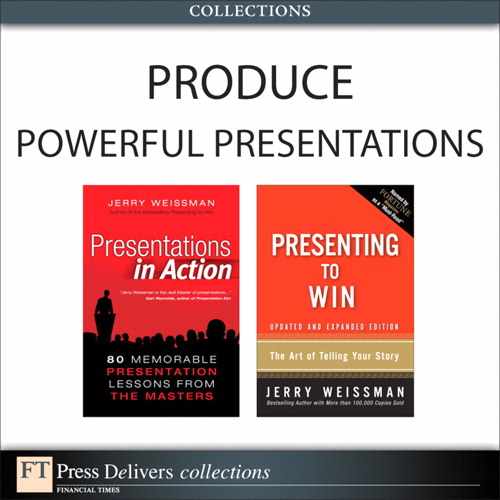In the theater, the finest play by the finest playwright, from William Shakespeare to Arthur Miller, can be affected . . . for good or for bad . . . by the staging. So it is with a presentation. You could create an effective Power Presentation with a lucid story and vivid graphics that uses every technique you learned in this book, only to have it all diminished by the presentation environment.
As the presenter, you bear the ultimate responsibility for your presentation. To ensure that you and your graphics have the maximum impact on your audience, it is your job to optimize the environment. Here’s a checklist:
- Familiarization. Arrive early and walk the entire presentation environment, not just the stage. Go to each part of the room and check the sight lines. Check, double-check, and triple-check everything.
- Equipment. Have a backup for each piece of technical equipment: computer, video, product demonstration, and projector. Remember Murphy’s Law: “Anything that can go wrong, will.” Also remember its corollary, Sullivan’s Law: “Murphy was an optimist.”
- Amplification. Check the sound system and test the microphone. Most presenters need amplification with an audience of 50 or more. If you are soft-spoken, use a microphone with an audience of 25 or more.
- Projection screen. Present with the screen to your left as you face the audience. In the discussion of Perception Psychology in Chapter 6, “Communicating Visually,” you learned that audiences in Western culture find it natural to move from left to right. With this arrangement, every time you click to a new slide, the audience travels from you to the screen and across the image easily and comfortably.
- Lighting. Keep the illumination low enough to create contrast on the screen, but never so dark that you lose eye contact with the members of your audience.
- Pointers. Lasers, retractable metal rods, lighted arrows, and saber-like wooden lances . . . all weapons . . . must be checked at the door. They are more hindrances than aids.
- Timing. Ask someone you know to sit in the audience during your presentation and send you countdown signals so that you finish in your allotted time.
- Liquids. Drink water to moisten your mouth. Avoid milk and milk products as they coat the throat with a film. Avoid carbonated beverages.
- Attire. “When in Rome, do as the Romans do.” Wear clothing appropriate to the event: suits for business occasions, and casual dress for informal occasions. Men: Button your suit jackets. Women: Leave your clanging or glittering jewelry at home.
Unfortunately, the world is not perfect. The best hotel banquet salons, the most modern executive briefing centers, and even the slickest conference rooms equipped with the newest, most expensive, highest-end equipment need to be fine-tuned. In the presentation world, the optimal is sometimes unattainable. If so, live with it.
If you overcome adversity, your audience will empathize with you, appreciate your effort, and value you more.
If the good Lord gives you a lemon, make lemonade!
